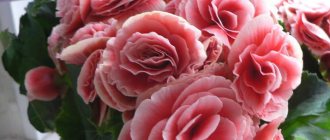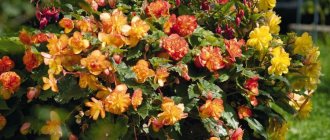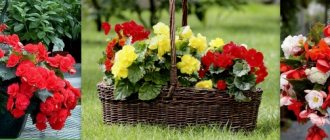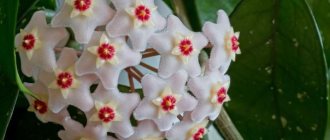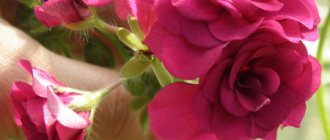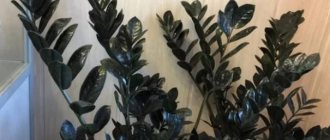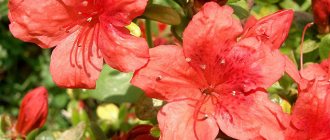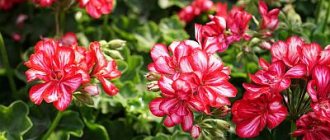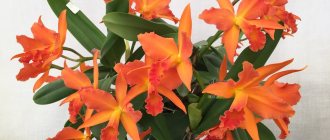The beautifully flowering sprekelia plant, also called sprekelia, stands out for its spectacular, graceful flowers. This evergreen bulbous plant is a member of the Amaryllis family. This genus unites only two species, namely: the magnificent sprekelia (Sprekelia howardii) and the most beautiful (Sprekelia formosissima).
This plant is also popularly called the Aztec lily. It is native to Guatemala and Mexico, and began to be grown in European countries in 1593. An adult bush reaches a height of approximately 30–35 centimeters. Flowering begins in the spring months or June. At this time, a peduncle appears on the bush, at the top of which a beautiful graceful flower opens.
When the bush fades, the plant must be provided with a period of rest. In indoor culture, the lifespan of such a flower is from 4 to 5 years. It has an average growth rate and is a perennial.
Description of the plant
The eye-catching flower represents the Amaryllis family. There are 2 varieties of sprekelia: Formosissima (most beautiful) and Howardii (magnificent). The plant comes from the mountainous regions of Mexico and Guatemala, where it is called the Aztec lily or Indian narcissus. During celebrations, the Aztecs decorated clothes and hair with sprekelia flowers.
The appearance of the Templar lily in Europe dates back to 1593, where it was brought by Spanish sailors.
Amazing exotic in the interior of the house
The height of the bulbous plant reaches 30 cm. In an adult bulb, the diameter reaches 10 cm. The rich green foliage has a shiny surface, a narrow, lanceolate shape. The length of the sheets is 40 cm, width – 5 cm.
When flowering, a smooth, hollow, red-brown stem is formed, which is crowned by a large asymmetrical flower. 6 elongated petals are intricately wrapped and form a beautiful shape.
Original petal shape
The red color of the petals comes in different shades. Many elongated, delicate stamens are covered with bright yellow pollen. Sprekelia smells nice when it blooms. In appearance it resembles an orchid.
Attention! Almost all representatives of Amaryllis are toxic. The content of alkaloids provokes intoxication. Sometimes contact with sprekelia juice causes irritation of the skin or mucous membranes.
Sprekelia splendor is classified as a heat-loving crop; it is afraid of the cold. The plant is considered a perennial, but in central Russia it is grown as an annual without special care.
Popular plant varieties:
- Karwinskii. The crimson petals have a white edge.
- Peru. The flowers have an intense red color.
- Orient Red. Red petals are characterized by white longitudinal inclusions.
Sprekelia varieties bloom in May or early June for 3-4 weeks. If you care for the flower correctly, it will bloom again in September.
Sprekelia
Sprekelia is a flowering plant belonging to the Amaryllidaceae family. It originates in the highlands of Guatemala and Mexico. It begins to bloom in early spring or in summer with large beautiful flowers.
Sprekelia formosissima is an evergreen bulbous plant that grows up to 30-35 centimeters. The bulb itself is black with dark red stripes, about 5 centimeters in diameter. The leaves are narrow and flat: the number of leaves is from 3 to 6, the length of which is 40-45 centimeters. The color of the leaves is rich green, sometimes red at the base.
A flower bud grows on a tall stem. It is an asymmetrical red bud. It consists of 6 petals, three of which “look” up and slightly tilted back, and the other three grow down, representing a tube with stamens. The stamens of the flower are red, at the end of which there are yellow anthers. The magnificent sprekelia blooms in spring or early summer.
Care at home and outdoors
Sprekelia pot
Anemones - growing and care in open ground
To grow a plant, choose the right pot. A container whose diameter is 3 cm larger than the diameter of the sprekel bulb is ideal.
Creating drainage using gravel, expanded clay, and broken bricks is appreciated.
Pot with drainage hole for sprekelia
When a crop grows in a cramped pot, it blooms faster. In order for daughter bulbs to form, a wider vessel will be required.
Soil and fertilizer
Distinctive features of flower soil are lightness, friability, and water permeability. The pH level is 5.5-6.5.
Beginner flower growers can use purchased soil mixture. If desired, prepare the substrate yourself using:
- turf – 2 parts;
- sand, humus, peat - 1 part each.
Add sphagnum moss, pine bark, and charcoal.
Substrate preparation
When planting in a pot, the bulb is buried halfway into the soil. Feed the sprekelia when a peduncle forms. Fertilizing is applied every 2 weeks until the end of the summer season. They use fertilizers for flowering crops.
Important! It is forbidden to fertilize sprekelia with organic matter: bird droppings, mullein, which provoke the death of flower bulbs.
Humidity and watering
Sprekelia is comfortable with dry air in the room; there is no need to moisten or spray the plant additionally.
In spring and summer, the flower needs intensive and abundant watering. It is preferable to moisten sprekelia in a tray or along the edge of a container. Do not allow water to get on the bulb and foliage. The transition to a dormant state is accompanied by a reduction in watering.
Sprekelia after the rain
When the leaves dry out, moisture is completely suspended. Do not allow moisture to stagnate in the flowerpot and do not over-moisten the soil. Excess moisture is responsible for rotting of the root bulb and death of the plant.
Temperature and light
When a crop is actively growing and blooming, it will need temperature support. This period falls during the warm season and there are no problems for sprekelia. Suitable temperature for a flower is +22…+25 °C.
On a note! Sprekelia is afraid of temperature changes. In summer, the plant prefers an unprotected flower garden.
With the onset of winter, a period of rest begins, which is characterized by a decrease in temperature to +16...+18 °C.
Sprekelia needs a lot of light. In addition, in the evening and in the morning the plant will need direct rays of the sun for at least 4 hours. At home, choose a place for the flower near windows that face east, west and south. To ensure uniform leaf growth, rotate the pot.
Culture does not like the location on the northern windows. A lack of light leads to stretching of the sheets, loss of color and a decrease in the decorativeness of the sprekel.
On the south side at midday it is useful to protect the sprekelia from the scorching sun. This applies to plants in open beds. In addition, the crop is protected from wind and drafts.
Sprekelia in the garden
Trimming
The manipulation is carried out after the plant has flowered. The peduncle is cut at a height of 3 cm from the bulbous neck. When the ground part of the sprekelia dies, the bulb is dug up and the dried foliage is cut off.
Hemanthus
houseplant411.com Hemanthus is an unpretentious bulbous flower that adapts well to indoor conditions.
Its leaves are dark green and dense, their length reaches 20–25 cm, width - 8–10 cm. Because of their shape, the plant is sometimes called “deer tongue”. Hemanthus blooms in late summer or autumn. The height of the peduncles usually does not exceed 25 cm. The inflorescences of the plant look like fluffy balls. The most popular indoor species, the white-flowered hemanthus, has milky white flowers, while the Katerina hemanthus has deep red ones.
Where to put
In a well-lit place. The plant must be protected from direct sun, otherwise unsightly burn spots will appear on the leaves, and over time they will die off altogether. From spring to autumn, hemanthus feels normal at normal room temperature. And in winter it needs coolness - from 12 to 15 ° C.
How to water
Moderately, the soil in the pot should have time to dry out by about half. Hemanthus does not tolerate stagnation of moisture in the soil and its waterlogging, so it is not worth flooding. High humidity and spraying are not needed.
Flower propagation methods
Fuchsia growing and care in the garden, in open ground
The flower is propagated by seed and baby bulbs.
How to plant a bulb
The daughter bulbs that form on the bottom of the adult are planted. For planting, 3 cm of onions with small roots are suitable.
Planting material
Use a knife to separate the onions. The cut site is disinfected with activated carbon. Planting material is planted in separate containers.
The procedure takes place in March. You will need fresh soil mixture. The bulb is not completely buried: the upper lobe and neck are opened. Water little by little. The formation of flower arrows is a signal to increase hydration. Fertilizer is added to the water.
It is possible to plant bulbs in flower beds in the spring.
Growing from seeds
If a crop is grown from seeds, the process is labor-intensive. Seed collection is carried out in mid-autumn. With the onset of spring, seed material is planted in containers with moistened, fertilized soil.
When seedlings appear and strengthen, they are planted at intervals of 10-15 cm from each other. Strengthened shoots are planted in unprotected soil. Plants grown from seeds bloom only in the third year of life. Sprekelia is actively working on the formation of a full-fledged tuber.
Sprekels obtain seed material after manual pollination of the plant. Propagation by seeds is not responsible for maintaining varietal qualities. Fresh seeds germinate within 3 weeks; sowing is not delayed and is carried out immediately after harvesting. Seed material loses its viability within 5 weeks.
On a note! The germination rate of fresh seeds is 100%, of dried seeds - 30%.
The seeds are scattered over the surface of the soil and lightly sprinkled. The temperature range is +22…+25 ˚С, humidity support is required. When the 3rd leaf appears, the young onions are transplanted into individual containers.
How to propagate?
Sprekelia can be propagated in two main ways:
- seeds;
- daughter bulbs (division).
The first method is the most labor-intensive and not always effective.
Seeds
In order to collect seed material from a flower, you must manually pollinate its inflorescences.
Reference. The seedlings that you receive from the collected seeds will not retain the characteristics of the mother bush.
It is imperative to sow the seed within the next five weeks after harvest, otherwise it simply will not sprout:
- Fill the planting container with a suitable soil mixture.
- Place the seeds on the surface of the soil and sprinkle with a thin layer of substrate.
- The air temperature during seed germination should be +22..+25 degrees, and high air humidity is also necessary.
- As soon as the seedlings form the third strong leaf, they should be planted in separate pots.
By division
An adult plant bulb forms many more “babies” at the bottom. They can be separated from the mother and transplanted into separate containers. Only those children that have already grown to 3 cm and have formed their own rhizome are suitable for planting.
It is enough to carefully cut off the onion with a clean and sharp knife, then treat the cut with crushed coal, and transplant the section into a separate planting container.
Transplantation rules for growing in open ground
Coleus flower - care and cultivation in open ground
At the dacha, the plant is grown as an annual, at home - up to 5 years.
When breeding sprekels, growing and caring for them in open ground requires compliance with certain requirements:
- purchasing bulbs shortly before planting;
- selection of a sunlit area, without drafts and stagnant water, with loose, fertile soil;
- planting seed material in March-May.
When landing, use the following scheme:
- depth of bulbs – 10 cm;
- The minimum distance between the bulbs is 10 cm.
Mulch the plantings with peat. When plants are grown in cold climates, the bulbs are dug up after the growing season has ended.
The final death of the leaves signals the digging and clearing of soil and dried tops. It is forbidden to trim the roots of the bulbs.
Store the bulbs cool in dry peat.
Peat for storing sprekels
Exceeding the temperature of +10 ° C causes germination ahead of schedule.
On a note! Water the seedlings twice a week. When it’s hot outside and the humidity is low, the number of waterings is increased to 3. Drained soil will eliminate water stagnation.
Why doesn't Ruellia bloom?
Sometimes it happens that a plant blooms for one year, and then with the onset of September it does not produce buds.
The reasons should be sought not in the flower, but in the conditions of its maintenance:
- Little light is the main reason. Confirmation of this will be the dull color of the greenery and elongated thin young shoots.
- Not enough heat - Ruellia is very thermophilic and if the temperature is low, the plant will not dare to bloom. If a beauty is standing on a window that is open all the time, the cause may be cold autumn nights and temperature changes. In winter, the cold can come from the glass or window frame; if it is not possible to remove the pot, you can place it on foam plastic.
- Drafts are something that Ruellia is very afraid of. Lack of flowering, loss of decorativeness, falling leaves - these are all the consequences of a draft.
- Growing in a pot that is too large. If there is a large earthen clod, the flower will be busy growing the root system. Only when the ruellia fills the pot with its roots will it bloom profusely.
Pinching young shoots stimulates ruellia to bush and throw out buds. Young shoots bloom more actively.
Caring for a flower during the dormant period
Sprekelia has a long dormant period. It lasts six months: begins in November and ends in March. They prepare the flower for it with the arrival of autumn, gradually reducing watering. When the last leaf disappears, the plant is not watered. The sprekel bulb is left in a flowerpot, the container is placed in a cool, dry room with a temperature in the range of +16...+18 °C.
If desired, remove the bulb from the pot, move it into a container with dry peat and place it in a cool place (+12...+13 °C) until the end of the winter season. With the arrival of spring, the bulb is planted again in a flowerpot. Moistening of the crop is resumed when the peduncle is formed.
If you plan to decorate an apartment, office, greenhouse or garden plot, the magnificent sprekelia will help out, planting and caring for it will not be difficult. This exotic plant will delight you with its bright colors and pleasant aroma in single plantings and in combination with other garden plants.
